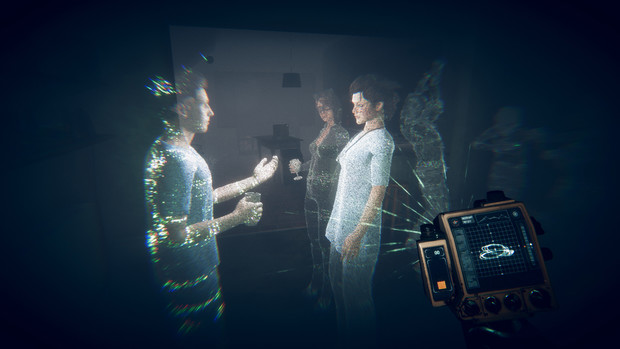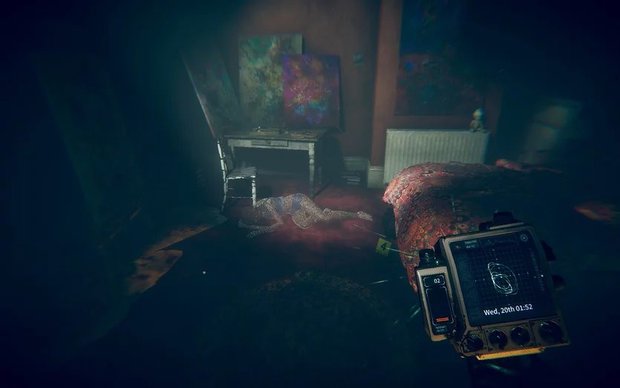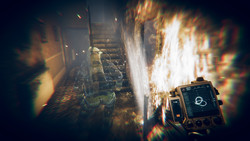Eternal Threads review – Time-manipulation thriller cleverly weaves together its narrative strands

- 1 Comment
It’s been theorized that traveling to the past, if possible, would be inadvisable due to a multitude of factors. The most prominent concern is the so-called butterfly effect, with seemingly small actions subsequently causing much more substantial changes in the future. In Eternal Threads, you’ll get to ponder this conundrum as you surgically (or recklessly) reorganize the past to better suit the future. Though the larger premise isn’t explored as much as it deserves, the game overcomes the issue of its inherently repetitive gameplay loop with great storytelling and the monumental challenge of solving one giant mega puzzle made up of dozens of individual decisions.
Eternal Threads opens with a briefing document from The Second Chance Project, read aloud by the program’s director, Dr. Anne Baker. The document explains that early experiments in time travel ended up devastating the past due to massive amounts of chronal radiation leaking into the timeline. The only way to fix this problem is, ironically, more time travel, albeit with a far more measured approach. By going back in time to influence and alter very specific events, it is the organization's goal to fix the future by altering the past, even if that means wiping themselves out of existence.
Players assume the role of field agent 43, beginning on a crossover pad (essentially a teleporter) in the agency’s bunker, with your handler communicating with you via radio, giving a few details about the mission. You have been tasked with traveling to Alberbeck, UK, 2015. An event that occurred there allegedly had a drastic effect on the future, and rewriting the outcome should partially restore what has been broken by the reckless use of time travel. Six people died in a house fire, and it’s your task to change the timeline so that all six survive. However, you’re only permitted to alter decisions made by the housemates in the week leading up to the fatal event.
Upon arriving in Alberbeck, the tone shifts from post-apocalyptic science fiction to daytime TV drama, and the connection to the end of the world takes a back seat, at least for a little while. Once in the house, you can take to exploring and setting up for your mission, though you cannot leave the property (this is supposed to be a stealth mission, and you don’t want to spook the neighbours). You cannot exit through the front door (nor the back gate, when you find access to the backyard later on), being completely confined to the small three-story property. Rain pours outside, and the clouds prevent much light from entering the house, making the whole ordeal quite unsettling. Luckily, your handler sent some hovering lights back with you to help illuminate the dwelling. The science is never explained, nor is 43’s gear or technology, but the game introduces it at such a natural pace that it never becomes confusing as to what something can do.
You’re first directed to set up the mission by accessing your Visualizer (a sort of handheld radar, like the one seen in Aliens) and establishing nodes around the house. Once done, you’ll watch the first of what will be many holographic renderings of the past, guided there by the marker on your Visualizer, which connotes where in the house the event took place. This first recording is of firefighters entering the house via the front entrance, using a hose to battle the flames. When the short replay ends, you are informed that the house burned down on Wednesday, May 20. With this marker placed at the end of your Time Map – an outline of the key events and choices leading up the fire – you can begin working backwards to alter history. Selecting an available event on the Time Map, a marker will then prompt on the Visualizer, guiding you to the correct area in order to watch another holographic rendering of the event.

Watching in order, seeing the story through from start to finish took me around two and a half hours, though of course the mission was nowhere close to being complete. You also don’t have to watch the events in order, though not all events will be selectable at any given time, regardless of what method you choose. Events are often labeled “Potential” on the timeline, and are only spawned into play if certain decisions are made. Events that allow you to pick one of two choices are connoted with a diamond shape on the Time Map. Altering these events could affect the fate of certain characters, and may unlock new Potential events for viewing.
The mission revolves around the six housemates living there. Tom, the landlord, is juggling several big troubles. His mother is sick, he’s having money issues, and his ex-girlfriend is … a handful. Linda, a woman going through something of a mid-life crisis, has temporarily moved in at the request of her brother Neil, a university student renting a room from Tom. Neil is an emotional young man, quick to anger, though he has a real sense of loyalty to his friends and family. Raquel is an arts student, and best friend of Jenny, who is a mathematician dating Ben, a doctor doing his residency. Over the course of the week, these housemates help (or ignore, if you so choose) one and other in different ways. A pregnancy test, an out-of-country job offer, anger management, romance, and even skeletons in the closet all come into play. It’s a riveting drama that really sucks you in, especially when you are looking on not as just a passive observer, but with the perspective that you may be able to steer the characters to different fates should you find the right opportunity to intervene.
For most of the game, Eternal Threads feels a bit like you’re watching an interactive episode of Coronation Street and not a sci- fi saga about trying to save a world ruined by radiation leaks and timeline chaos. It’s a testament to the storytelling that the character drama so quickly overtakes the broader premise, though how exactly these events connect to one another is something only hinted at.
Getting all of the housemates out alive is one thing, but they all have optimal endings as well as just passable ones. You can see which outcome they’ll arrive at, as well as whether they are alive or dead, at the end of the current Time Map. Getting the best possible ending for all of them not only involves altering the narrative at specific points, but also exploring the house in its entirety. There are several locked doors, safes, and items only accessible once you see one of the characters interact with them in a holographic replay, or trigger certain items to appear by making specific choices.
Occasionally your handler will interject, making notes about the situation, giving hints or ideas as to what to do next, or even letting you know about a timeline anomaly in the house. Several of these, like a light drone going down, seem trivial (albeit unnerving), though depending on your alterations of the Time Map and your exploration of the house they may reveal additional bits of the environment.

While the concept of looking for clues through Time Map events was clear enough, I failed to notice for the first few hours that my choices on the Time Map also changed the physical makeup of the house. Just as the house is left in a certain state when you first arrive, with all six housemates deceased, the house itself changes as you alter their choices, affecting text messages left on phones, items put in storage, new clues revealed, and more.
There are nearly 200 events, over 50 of which are choices that can be altered (an “easy” mode, with only 37 choices and 121 events, is also selectable). Some of these events end up being superfluous, while others can have major impacts on the plot. Though watching these choices play out is recommended the first time, you can easily alter a choice in the Time Map for convenience without having to sit and watch the event should you wish. The Time Map also shows how any given choice is connected to different Potential events, as indicated by a dotted line flowing down the Time Map and linking to other Potential events.
It can seem a bit tedious at first, staring at the Time Map, carefully following the link between events while you wrack your brain for creating new potential scenarios, but the flow between cinematics and gameplay is balanced quite well. In the house, you’re free to explore, opening drawers and searching rooms for clues. This investigative side of the otherwise cinematic-leaning gameplay blends well with the Time Map interaction, giving you the opportunity to think about connections, referring to the Time Map to look for events that took place in a certain room, or with a certain character, unlocking new routes in the story. I found juggling all of the plot details to be overwhelming at times, and an in-game note system would have been a nice quality-of-life feature, though taking notes the old-fashioned way was an effective means of focusing my efforts as well.
I played through the story in a more or less linear fashion the first time through, watching all of the events in sequence and making choices at random. I saved two of the six housemates by the end before starting back, re-examining the Time Map. This second leg of the game was far more demanding, taking around five hours to complete. It involved a lot of staring at the Time Map, focusing on one character at a time, trying to alter events in order to get them out alive (and happy). Getting everyone out alive often means undoing some (seemingly) sound choices in order to go down new routes, unlocking new Potential events in order to get clues, new choices, or better insight into each character’s motivation before perhaps switching back. And though you only need to rescue the six characters to complete the game, in order to see the true ending you’ll need to tinker a bit more.
This back and forth between options, though laborious, proved surprisingly addictive. Several times after shutting down the game, I thought I would be stuck upon resuming, having exhausted my ideas of how to better alter the timeline. Yet whenever I returned, I always seemed to find a new route to take, and eventually I got all six out alive – albeit not with everyone at their happiest ever after. Still, I chose to end the game at this point, being given the go-ahead to return to base should I wish. Having found several anomalies in the house that my handler noted as unexplainable, the ending I got was a suspenseful climax, refocusing more on 43 and the ruined world they came from than the fate of the housemates. That said, there were plenty of threads I know I left hanging, more than enough to entice me back for a second full playthrough to see an entirely different ending.
Eternal Threads is played entirely from a first-person perspective. You don’t get a good look at 43, nor ever hear from them, allowing you to project yourself into the role. The view through your hazmat suit visor, with the crinkling rubber of your gloves and outer layer, keep you firmly immersed in the role. It feels alien, and a bit creepy, skulking through the dark house, peering into the lives of six strangers. Despite the familiar, entirely relatable setting, the game does a good job of making you feel out of place. These details, along with the holographic replays, keep the narrative’s post-apocalyptic foundation present, even if you have to remind yourself of the grander scope from time to time.
The game uses a standard WASD control scheme, with handy keystrokes to bring up the Time Map, interact with a scene or object, or to sprint. Controllers are supported, though I didn’t get the chance to try one out. Regardless of the method you use, speed and fluidity aren’t of any concern seeing as the game has no platforming or time-sensitive sequences.
The dialogue is fully voiced, and all of the actors do a tremendous job of portraying their roles. Music is reserved, though notable when it chimes in, like the introductory song by the band Strange Collective. Animation is similarly excellent but the graphics are slightly basic, with the housemates notably lacking in facial animations, while textures like clothing look more like solid pieces welded to bodies than loose pieces of fabric. However, thanks to the holographic rendering and the innate darkness of the house, many of the visual blemishes are smartly hidden.
Final Verdict
At times Eternal Threads is like a meticulous switchboard. It takes patience and thought to get through, but despite its seemingly simple and repetitive design, it never feels like a drag. Becoming an architect of fate is empowering, voyeuristic, and unsettling, but nevertheless optimistic. Honing in on clues, testing theories, and trying to gain access to all of the house’s hidden areas combine to make this seemingly finite event surprisingly replayable and adjustable. Fans of choice-heavy games will get a kick out of the player agency offered here, regardless of what difficulty you’re comfortable with playing at. I hope we see more of 43 in the future (and past), as the mysterious world Cosmonaut Studios has created is one I’m keen to transport into again.
Hot take
Eternal Threads is an empowering yet equally unsettling voyeuristic adventure. It can be overwhelming trying to keep track of all the loose threads of time you’re able to weave, but even at its most challenging moments, it’s never less than a deeply immersive, character-driven time travel mystery.
Pros
- Great storytelling, blending contemporary drama with a cool science fiction premise
- Gameplay combines traditional adventure exploration with narrative manipulation in a unique way
- Atmospheric setting keeps things dark and mysterious
Cons
- Graphics aren’t as lifelike as the story deserves, though the weaknesses are smartly obscured
- An in-game note or bookmark system would have been welcome
Drew played Eternal Threads on PC using a review code provided by the game's publisher.

- Advertisement
- Help support AGH by advertising with us











1 Comment
Want to join the discussion? Leave a comment as guest, sign in or register.
Very nice review, thank you winfrey
Reply
Leave a comment